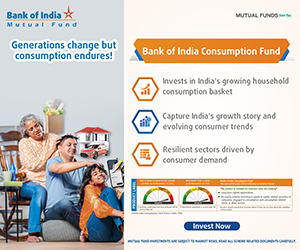BSE sector performance and pointers for future outperformance: Part 1

Buy and hold is a time tested principle of equity investing. However, for savvy investors, the market gives opportunity to earn high returns, even in the short and medium term, in the form of stock specific or sector specific investment ideas. In this two part series, we will discuss the performance of various sector indices in Bombay Stock Exchange (BSE) and some pointers for future outperformance. Readers should note that, while historical prices can provide some indicators for future performance of a sector, sector performance depends on a variety of factors like government policies, monetary policy, global commodity prices, exchange rates and other global factors. Readers should also note that for average investors, large cap and diversified equity funds are the most suitable instruments for equity investing. Sector specific requires expertise and an active investment management approach. Timing is very important in sector investments, since it makes a big difference to returns in the short and medium term.
BSE tracks several industry sectors through its sector indices. There are indices for Automobiles, Banks, Consumer Durables, Capital Goods, Healthcare, FMCG, IT, Metals, Oil and Gas, Power, Realty and Technology, Media & Telecom. We will analyse the performance of the first six sectors in this part of the series, and the performance of the other six sectors in the next part of the series. For our analysis, we have taken the daily prices of these indices for the past 5 years, from May 21 2009 to May 21 2014.
S&P BSE Auto Index
The S&P BSE Auto Index is the benchmark index for the automobile sector and comprises of select large cap automobile and auto ancillary stocks trading on BSE. Stocks like Maruti Suzuki, Bajaj Auto, Mahindra and Mahindra, Tata Motors, Hero Motorcorp, Exide, MRF etc form the S&P BSE Auto Index. Below is the 5 year daily price chart of the S&P BSE Auto Index.
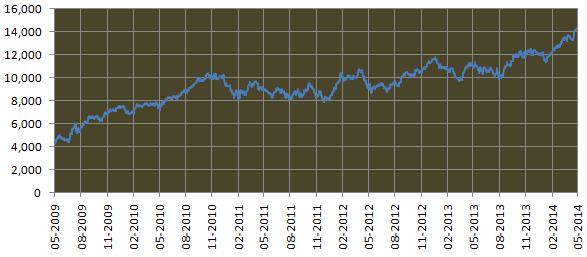
We can see the 5 year trend of the S&P BSE Auto Index is upwards. There was a period of consolidation in 2011. But after the period of consolidation, the index has been making new highs. Between May 2011 and May 2012 the index was choppy. Between May 2012 and May 2013 the index rose by 20%. In the last one year the index rose 15%. The table below shows the returns from the BSE auto index over the last 5 years (returns over 1 year are annualized).

In the last 5 years, the sector has given trailing compounded annual returns of 26%. As of close of trading on May 21 2014, the BSE Auto Index was only 5% away from its 5 year high. However, the sector has the potential of going much higher as has been the trend of this sector over the 5 years (except the 2011 market correction period). The automobile sector is a cyclical sector, which means that the sector performs well when the economic growth revives. Momentum is clearly in favour of this sector as can be seen from the 18% rise in the index over the last 3 months.
S&P BSE Bankex
The S&P BSE Bankex is the benchmark index of the banking sector and comprises of select large cap public sector and private sector banks. Banks like ICICI Bank, HDFC Bank, Axis Bank, State Bank of India, Punjab National Bank, Bank of Baroda etc. form the S&P BSE Bankex. Below is the 5 year daily price chart of the S&P BSE Bankex.
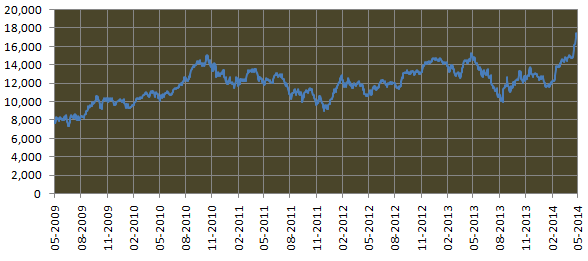
We can see while the 5 year trend of the S&P BSE Bankex is generally upwards, the sector is very volatile. There was a sharp correction of more than 25% in 2011. From May 2012 to May 2013 the Bankex rose 38%. From May 2013 to Sep 2013, it again corrected nearly 30%. Since September 2013 the index has been very volatile, but has risen sharply with every up move. In fact over the last three to six months the Bankex has led the rally in the Sensex, and is now close to its 5 year high. But it can go even higher, given that the trend is positive. The table below shows the returns from the S&P BSE Bankex over the last 5 years (returns over 1 year are annualized).

In the last 5 years the banking sector has given trailing compounded annual returns of 17%. Momentum is clearly in favour of the sector since in the last three months the index has risen 42%. But since banking stocks have run up significantly, at higher levels short term profit booking is likely and therefore they are likely to be very volatile. This sector also has a direct linkage with the inflation and monetary policy. Any adverse development on that front has an impact on the banking stocks. However, this sector has the potential of giving very strong returns, as evident in its historical performance, if one can ride out the short term volatility. This sector is also the bell weather sector for the whole economy and therefore, if the economy returns to the high growth trajectory, this sector is bound to perform very strongly.
S&P BSE CD
The S&P BSE CD is the benchmark index of the consumer durables sector and comprises of select large cap companies in the consumer durables space. Companies like Titan, Whirlpool, Videocon, Gitanjali Gems, PC Jewellers, Bajaj Electric etc. form the S&P BSE CD. Below is the 5 year daily price chart of the S&P BSE CD.
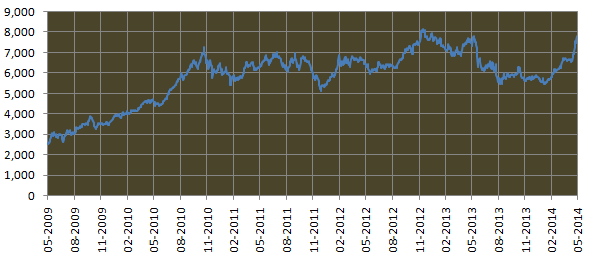
We can see that the 5 year trend of this sector is upwards, but very choppy. There was longish period of consolidation from 2011 to the middle of 2012. Thereafter, the trend was positive till the middle of 2013, after which there was there was sharp correction in which the Consumer Durable index gave up all its gains over the past one year and went into another period of consolidation. The index has picked up steam in the last three months and is now within 6% of its 5 year high. The table below shows the returns from the S&P BSE CD over the last 5 years (returns over 1 year are annualized).

In the last 5 years the consumer durables sector has given trailing compounded annual returns of 25%. Recent momentum is clearly in favour of the sector since in the last three months the index has risen 39%. But we have to see, if there is conviction in the up move, since the move has taken place only in the last 3 months. The last one year return from this sector is only 4%. The consumer durable is a cyclical sector and should do well when economic growth revives. The sector is close to its 5 year high but it can go higher if the positive trend in the broader market persists. Investors need to watch this sector before taking aggressive sector bets. However, there are companies in this sector, e.g. Titan Industries which have excellent short to medium term potential.
S&P BSE CG
The S&P BSE CG is the benchmark index of the capital goods durables sector and comprises of select large cap companies in the capital goods space. Companies like BHEL, Larsen and Toubro, Punj Lloyd, Compton Greaves, Bharat Electronics, Welspun Corp, ABB, Siemens etc. form the S&P BSE CG. The capital goods sector is a typical cyclical sector. This sector has been underperforming since the end of 2010 to as recently as March 2014. Below is the 5 year daily price chart of the S&P BSE CG.
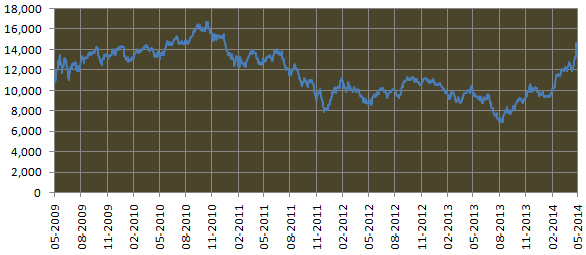
This sector has been a rank underperformer in the last 5 years. The index saw a sharp correction of nearly 50% in 2011. Over the entire 5 year period the performance has been extremely choppy. However, the index bottomed out in August 2013 and has been rising steadily since then. From May 2012 to May 2013 the index gave a return of 13%, and from May 2013 to May 2014 the index gave a return of 39%. The table below shows the returns from the S&P BSE CG over the last 5 years (returns over 1 year are annualized).

In the last 5 years the capital goods sector has given trailing compounded annual returns of only 6%. However, momentum is clearly in favour of this sector. In the last six months the index rose by 61% and in the last three months the index rose by 46%. Despite the sharp increase over the past 6 months, the index is still 17% away from its 5 year high. This can give the investors, a sense of returns they can expect from this sector, in the short to medium term, if the positive trend continues. In fact, given the trend, the index has the potential of beating its 5 year high and form new highs in the coming months. This sector also has a direct linkage with fiscal policies, economic growth and revival of the capex cycle in our economy. The future potential of this sector seems to be very strong.
S&P BSE HC
The S&P BSE HC is the benchmark index of the healthcare sector and comprises of select large cap companies in the pharmaceuticals and healthcare space. Companies like Ranbaxy, Sun Pharma, Dr Reddy’s Labs, Cipla, Glenmark, Ipca, Glaxosmithkline, Ipca Labs, Aurobindo Pharma, Piramal Enterprises, Biocon, Apollo Hospitals etc. form the S&P BSE HC. The healthcare sector is a typical defensive sector. A defensive sector is one whose earnings growth and share prices have very low correlation to the GDP growth in the economy. Irrespective of economic growth, the revenues, the earnings and the cash flows of the company remain relatively stable. Defensive sectors like healthcare outperform cyclical sectors in bear markets. Sectors like healthcare do well in both bull market and bear market. However, in bull market cyclical sectors outperform defensive sectors. Below is the 5 year daily price chart of the S&P BSE HC.
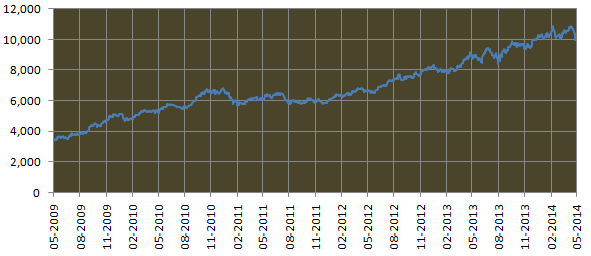
This sector has given one of the strongest returns among all other sectors in the last 5 years. The trend over this period has been upwards, except a brief period of consolidation in 2011. Even in the broader market correction of 2011, the healthcare index did not decline. From May 2012 to May 2013 the index gave a return of 34%, and from May 2013 to May 2014 the index gave a return of 13%. The table below shows the returns from the S&P BSE HC over the last 5 years (returns over 1 year are annualized).

In the last 5 years, the sector has given trailing compounded annual returns of 25%. As of close of trading on May 21 2014, the BSE healthcare index was only 8% away from its 5 year high. However, with cyclical stocks back in favour, investors are rebalancing their portfolios by shifting from defensives to cyclical stocks, hence the underperformance over the past few months. In the short to medium term, this sector is not likely to give high returns. However, long term potential of this sector remains very strong.
S&P BSE FMCG
The S&P BSE FMCG is the benchmark index of the fast moving consumer goods (FMCG) sector and comprises of select large cap companies in this sector. Companies like ITC, Hindustan Unilever, Colgate, Dabur India, Marico, Nestle, United Breweries, Godrej Consumer etc. form the S&P BSE FMCG. The healthcare sector is another typical example of a defensive sector. Below is the 5 year daily price chart of the S&P BSE FMCG.
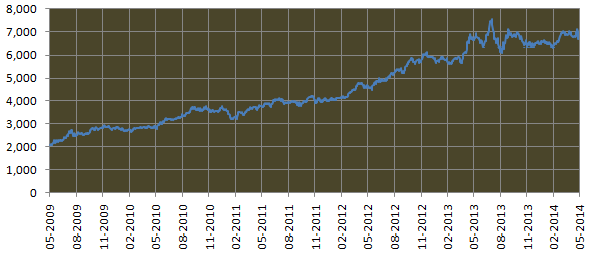
This sector has given one of the strongest returns among all other sectors in the last 5 years. The trend over this period has been upwards, except a brief period of choppiness in 2013. Even in the broader market correction of 2011, the FMCG index gave positive returns. From May 2012 to May 2013 the index gave a return of 43%, and from May 2013 to May 2014 the index gave a return of only 2%. The FMCG index has largely been flat for the last 6 months. The table below shows the returns from the S&P BSE FMCG over the last 5 years (returns over 1 year are annualized).

In the last 5 years, the sector has given trailing compounded annual returns of 27%. As of close of trading on May 21 2014, the BSE FMCG index was 12% away from its 5 year high. However, with cyclical stocks back in favour investors are rebalancing their portfolios by shifting from defensives to cyclical stocks, hence the underperformance, over the past few months. In the short to medium term, this sector is not likely to give high returns. However, long term potential of this sector remains very strong.
Conclusion
In this article, we have seen how each of the six sectors discussed above performed over the last 5 years. We have also got some pointers for potential future outperformance or underperformance. We should reiterate that, for sector specific investments, timing, both entry and exit is very important. These investment ideas are suitable for informed and active investors. Tomorrow we will discuss the performance of the six other industry sectors in BSE.
Queries
-
What is the benefit of mutual fund STP
Aug 29, 2019
-
How much to invest to meet target amount of Rs 2 Crores
Aug 26, 2019
-
Can I achieve my financial goals with my current mutual fund investments
Aug 24, 2019
-
Can you tell me return of various indices
Aug 19, 2019
-
What would be the post tax return on different investments
Aug 18, 2019
-
Which Principal Mutual Fund scheme will be suitable for my retirement corpus
Aug 16, 2019
-
What is the minimum holding period for availing NCD interest
Aug 4, 2019
Top Performing Mutual Funds
Recommended Reading
Fund News
-
DSP Mutual Fund launches DSP Nifty Next 50 ETF
Dec 19, 2025 by Advisorkhoj Team
-
DSP Mutual Fund launches DSP Nifty 500 Index Fund
Dec 19, 2025 by Advisorkhoj Team
-
Kotak Mahindra Mutual Fund launches Kotak Nifty Next 50 ETF
Dec 18, 2025 by Advisorkhoj Team
-
The Wealth Company Mutual Fund launches The Wealth Company Gold ETF
Dec 16, 2025 by Advisorkhoj Team
-
Axis Mutual Fund launches Axis Gold and Silver Passive FOF
Dec 10, 2025 by Advisorkhoj Team






